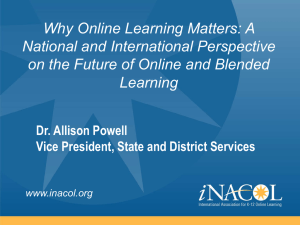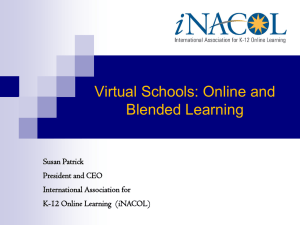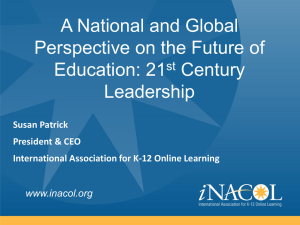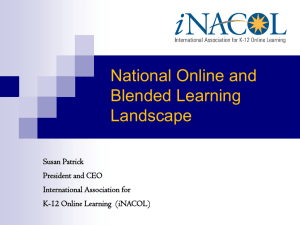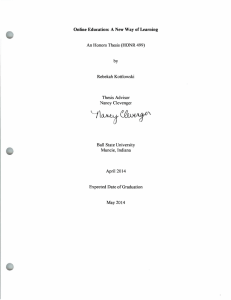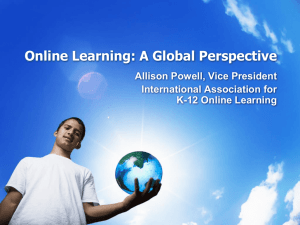Why Online Learning Matters (PPT Format)
advertisement
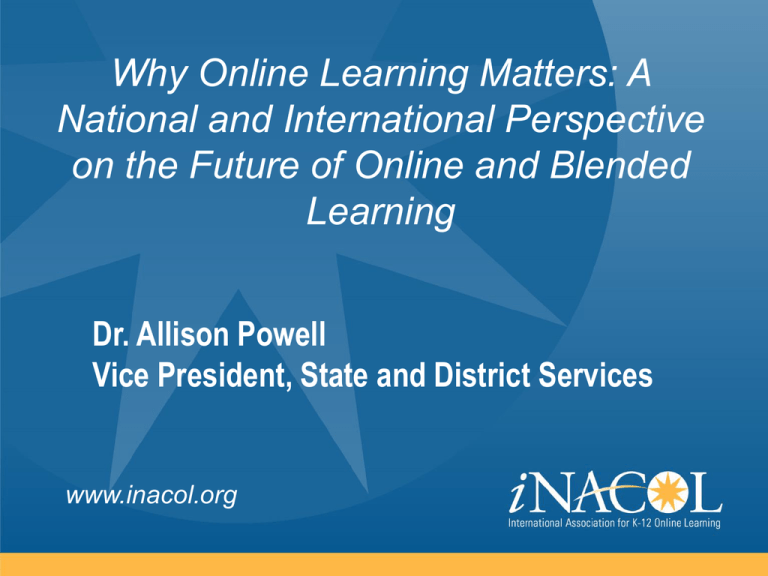
Why Online Learning Matters: A National and International Perspective on the Future of Online and Blended Learning Dr. Allison Powell Vice President, State and District Services www.inacol.org International Association for K12 Online Learning (iNACOL) • iNACOL is the premier K-12 nonprofit in online learning • 4300+ members in K-12 virtual schools and online learning representing over 50 countries • Provides leadership, advocacy, research, training, and networking with experts in K-12 online learning. • “Ensure every student has access to the best education available regardless of geography, income or background.” • Conference – Virtual School Symposium (VSS): New Orleans, LA on October 21-24, 2012 Disrupting Class Christensen suggests that by 2019 about half of all high school courses will be online. www.inacol.org Source: Susan Patrick, iNACOL Providing Opportunities to All Students Traditional Public/Private Accelerated Students Credit Recovery Medically Fragile Need to work and/or support family Rural Students Home Schoolers Special Education and ELL Aspiring athletes and performers www.inacol.org Online Learning in the United States • States with online learning policies: 50 • State virtual schools or statewide initiatives for online learning: 40 • States with full-time online learning programs: 30 + D.C. (250,000 students) • 50% of employers use e-learning for training • 1 in 4 undergraduate and graduate student enrolls in an online course in higher education; 5.9 million college students take online courses. • 82% of school districts had one or more students in a fully-online or blended course • • More universities are offering K-12 courses online – MIT open courseware for K-12 students – Stanford, Northwestern programs for gifted K-12 online learning enrollments growing 30% annually (50,000 in 2000; 2 million enrollments in 2008-2009; 2.5 million in 2011). Keeping Pace with K-12 Online Learning, Evergreen Education Group, www.kpk12.com Big Trends to watch: • District programs – new learning models using online and blended learning within single districts • Blended learning & Continuity of Learning • Policy revision - 16 states pass online learning laws – 7 States require online learning as HS graduation – Competency-based (Utah, New Hampshire, FLVS) • Instructional materials and open access - with common core (44 states), districts and states developing materials for PD, content and learning materials are moving toward open policies for content created with taxpayer dollars so it can be shared across schools State Online Learning Trends & Examples • Michigan, Alabama, Florida, Georgia, Idaho, Virginia, and West Virginia : – Online learning HS graduation requirement • Florida – Funded through performance-budgeting system • Utah – Funding follows student down to course level • Montana: new state virtual school – Managed by the University of Montana’s College of Education State Online Learning Trends & Examples • California, Texas, Virginia, Washington, Kentucky – Course quality – review all online courses against iNACOL online course standards • Virtual Charter Schools – Florida (blended too), Georgia, Indiana, Louisiana, New Jersey • More Districts – A shift to districts starting their own online programs Key District Trends • Small % of districts offering comprehensive online options—likely no more than 10%—but number is increasing fast • Decision-makers are sometimes schoolbased but moving towards district-wide decisions • Key factors are cost, competition, and addressing gaps in opportunities www.inacol.org International Perspective www.inacol.org World Future Society Top 10 breakthroughs transforming life over the next 20-30 years Best forecast data ever assembled 1. 2. 3. 4. 5. 6. 7. 8. 9. 10. Alternative energy Desalination of water Precision farming Biometrics Quantum computers Entertainment on demand Global access Virtual education or distance learning Nanotechnology Smart Robots Survey Findings • Almost 60 percent of the surveyed countries reported government funding for blended or online programs at the primary and secondary levels. • China’s first online school was created in 1996; today it has expanded to more than 200 online schools with enrollments exceeding 600,000 students. • Seventy-two percent of the surveyed countries reported that their online and blended classroom teachers participated in professional development for online teaching. • Universities and colleges were reported as the primary source of training for educators, followed by regional centers and local schools. Survey Findings • In British Columbia, online schools provide complete programs or individual courses to 71,000 students, which is about 12% of the student population. • In 2010, Hong Kong enacted a policy recommendation for digital learning that “de-bundled” textbooks and teaching materials to make them more affordable and accessible to schools, and accelerated the development of an online depository of curriculum-based learning and teaching resources. A pilot scheme later resulted in a program made available to all 410,000 primary and secondary students in 300,000 low-income families—especially the 8 percent without Internet access at home—to gain access to the Internet for the purpose of learning. Mexico • K-12 Digital Content, Laptop for Every Teacher, Preservice methods using engaging digital content, new strategies iNACOL Canada Study All 13 Provinces and Territories offer K-12 online learning eLearning Ontario • Ontario Ministry of Education - eLearning Ontario – Provides LMS for all 72 districts – Funds and oversees the development of eLearning courses – Online content uploaded into the Ontario Educational Resource Bank (OERB) which all Ontario teachers, students and parents can access • Solutions for credit recovery, differentiated instruction and as a study tool for students – Online courses at day schools funded at the same level as face-2face day school courses • The eLearning Ontario website is http://www.edu.gov.on.ca/elearning Australia • Pioneer in distance education, mainly servicing isolated rural schools and families • Curriculum breadth and opportunities for students in rural and small schools still limited • Online provision available in each state served via Blackboard, Moodle etc. • Nationally, much is first generation online content – flat text, limited interactivity and use of Web 2.0 capacity • Federal funded national rollout of 1:1 computing across years 9-12 by end of 2011 New Zealand • Professional Development – ICT PD • Teacher Laptop Program • National Broadband Initiative • Virtual Learning Network European Union • EU: – EU E-Learning Action Plan – IB Diploma Programme Online (125 countries) – New Line Learning Schools • UK: E-Learning Exports - 29 billion pounds annually; deal with China – Education as an export Turkey, the Middle East & Arab Spring • Turkey: online courses • Arab Bureau of Education for the Gulf States • Size India – 1 billion+, 70% rural population – Need 200,000 more schools • Internet Accessibility – 2007-08 - 42 million users (3.7%) • Online Learning – Universal access for K-12 in 10 yrs – Shortage of good teachers – “Leverage teachers using technology to bring to scale” – Educomp digitizing learning resources for K-12 Education Hong Kong – Blended learning for Continuity of Learning South Korea • South Korea – National Virtual School – Switch to digital content from textbooks China • China: 1.3 billion people • Digitized K-12 curriculum • Training Master Teachers to teach online • With online learning: increase educational opportunities to 100 million new students The Futurist: Education 2011 China may be the first country to succeed in educating most of its population through the Internet. – From 2003-2007, China spent about $1 billion to implement online learning projects in the rural country-side. Singapore • Singapore: 100% of Secondary schools use online learning • All teachers trained to teach online • Blended Learning Environments • E-Learning Weeks Trends in Education: Next Generation Models of Online and Blended Learning www.inacol.org Blended learning A formal education program in which a student learns at least in part through online delivery of instruction and content, with some element of student control over time, place, path and/or pace and at least in part in a supervised brick-andmortar location away from home. Tech-rich = blended Emerging models of blended learning Rotation • • • • Station rotation Lab rotation Flipped Classroom Individual rotation Flex Online platform with F2F support and fluid schedules Self-Blend Students attend physical school & take 1 or more courses online Enriched Virtual Students learn sometimes at a physical school, other times remotely Competency-based learning (definition) 1. Students advance upon mastery. 2. Competencies include explicit, measurable, transferable learning objectives that empower students. 3. Assessment is meaningful and a positive learning experience for students. 4. Students receive timely, differentiated support based on their individual learning needs. 5. Learning outcomes emphasize competencies that include application and creation of knowledge, along with the development of important skills and dispositions. National Standards for Quality Online Programs, Online Teaching & Online Courses Online Learning Research • #1 Online Learning Expands Options • “The first impetus to the growth of K-12 distance education was an interest in expanding educational options and providing equal opportunities for all learners.” (NCREL 2005) • #2 Online Learning Is Rapidly Growing • “Recent Surveys show that K-12 online learning is a rapidly growing phenomenon.” – Growing 30% annually – 50,000 enrollments in 2000 – Over 2,000,000 enrollments in 2010 Online Learning Research • #3 Is Effective: “Better” • U.S. Department of Education Report of Online Learning Better than Face-to-Face (USED 2009) • #4 Improves Teaching • Teachers who teach online reported positive improvements in face-to-face, too. • “Of those who reported teaching face-to-face while teaching online or subsequently, three in four reported a positive impact on their face-to-face teaching.” Project Tomorrow Survey (2009) • Benefits of taking a class online? – According to students: • 51% said it allows them to work at their own pace • 49% to earn college credit • 44% said it allows them to take a class not offered on campus • 35% said it was to get extra help • 19% said they took online courses to get more attention from teachers How well is our current K-12 system functioning? Depends on who you ask http://www.youtube.com/watch?v=_LyuLJSByvI How Students Learn Questions Dr. Allison Powell apowell@inacol.org http://www.inacol.org http://onlineprogramhowto.org
